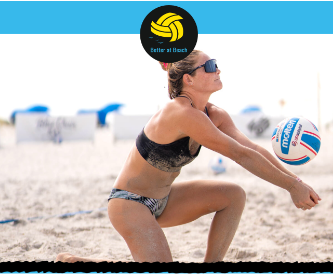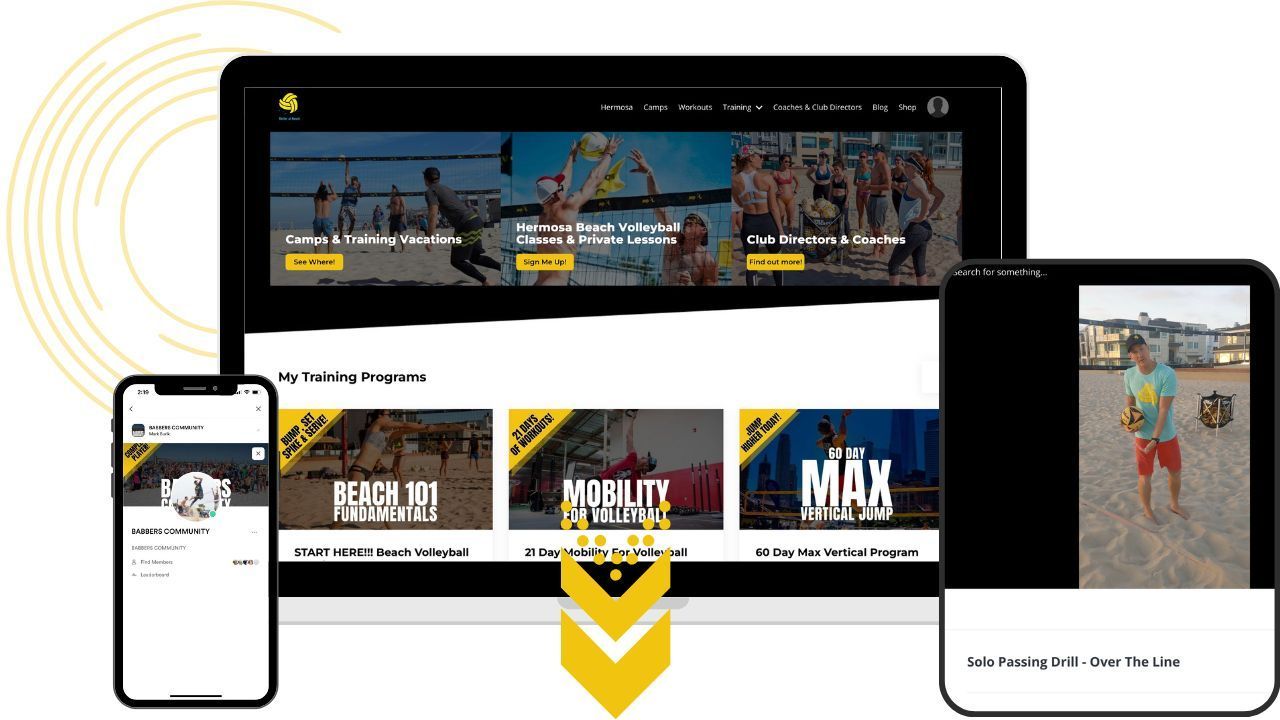
3 Vital Skills to Master in Beach Volleyball: Passing, Setting & Hitting
3 Vital Skills To Master in Beach Volleyball
Losing points on serve receive?
Missing critical hits?
In this post we’ll show you how to perfect your pass, set clean, and attack confidently.
How to Pass A Beach Volleyball -
Passing in Beach Volleyball has 3 steps:
- Build Your Platform
- Hold Your Platform Longer than You Want To!
- Footwork for Passing in Volleyball
Build Your Platform
First things first, what do our hands look like when passing? With all your fingers on one hand touching and palms flat, put one set of fingers (except the thumbs) on top of the other, perpendicular to each other. Now, make your thumbs “kiss” (two thumbs touching and parallel to each other).
Why you shouldn’t interlace your fingers in your platform during serve receive -
We absolutely do not want to intertwine our fingers because if a really hard serve hits your hands wrong, it could lead to some broken fingers.
Next, make sure your arms are completely straight with no bend in your elbows - think about hyper-extending your elbows, and hunching your shoulder blades forward to try to press your elbows together. And there is your perfect platform for passing in beach volleyball.
Take a look at our “President of Morale” and Professional Beach Volleyball Player, Ali Denney, as she demonstrates the perfect platform below.

Hold your platform longer than you want to!
One of the biggest mistakes people make when passing in volleyball is breaking their hands/platform apart too quickly. This leads to a fast touch on the ball. We want a long, slow touch. Make it feel like you are touching the ball for as long as possible. After the pass leaves your platform, you should hold your platform strong and steady for a full second.
Footwork for Passing in Volleyball -
“Step, Plant, Plant.”
Yes, some serves will take more than 3 steps to get to, or you’ll have to dive. But, you should be able to cover MOST of your area with a step, plant, plant. We want the first step to be with your “lead leg''. This means, if the serve goes to your right, you take a big, strong first step with your right leg and vice versa (no crossover steps). Then, we want our “plant, plant” to stabilize us and keep us balanced. If the lower half of our body is not stable, our upper half and therefore platform will not be stable either.
If you want to pass perfect every time, check out our Serve Receive Master Class.
We are going to help you pass with more accuracy, more consistency and more confidence! Get the positioning and the mechanics to control the first touch against any server, in any weather. You’ll also learn to develop a mindset that keeps you in the game so you can stay focused and win matches.
Other tips to help you pass better in beach volleyball
- Communication with Your Partner
- Get an EARLY read on the ball
- Watch how the ball is coming off the server’s hand
- Look the ball into your Platform
- Know when to use passing angles
How to Set In Beach Volleyball
5 Key Points to Setting Like the Pros in Beach Volleyball
- Don’t Release EARLY and Be Patient!
- Follow the ball instead of waiting
- Square Up to Your Target
- Off Foot, Net Foot, Set
- Focus on the hand shape
Don't Release EARLY and Be Patient! -
You don’t want to run to the net and wait for the set facing your partner. When the ball is served, and you know the ball is going to your partner, you should be roughly two steps by the time they touch the ball. Your partner should be passing above the antenna to give you time to patiently arrive in the perfect location for setting.
Follow the Ball Instead of Waiting -
Make sure you are following the ball in instead of waiting for it from the net. This will allow you ample time to adjust if there are any other factors that could potentially change the play, such as wind or hitting the top of the tape.
Want to show your support and help us make more content?
Buy one of these cool beach volleyball gears...
 |
 |
|---|---|
| Premium Tee | ALPHAWORX Agility Ladder |
Square Up to Your Target -
Unlike passing, where your shoulders should be square to the net, setting is going to be easiest when you are square to your target. Make sure your belly button, toes, and shoulders are facing where you want to set. Just think about three point shooters in basketball. They are squaring up to their target before shooting. So, you should always try to finish a set with your belly button facing your attacker. If you are able to be square while setting then you have made the skill as easy as you can relying on a straight pass/set.
Off Foot, Net Foot, Set-
When approaching the ball to set, you should think about getting your net foot forward. The reason we say ‘net foot’ is because throughout a play you may have your left foot or right foot forward depending on what side of the court you are on. There are two reasons why this is going to be important.
First, it will allow you to develop a rhythm to your set because you will be moving from your back foot to your front foot, allowing your energy to end up on your front foot during contact. This rhythm will allow your set to be something you can replicate while also allowing your hitter to pick up on your rhythm which will make the set easier for them to get to.
Second, it will allow you to accomplish the next beach volleyball setting key discussed..
Focus On the Hand Shape -
You want to focus on your hand shape when hand setting. Mark loves to call it the "cheeseburger" hand shape, as if you were eating a juicy cheeseburger. This also helps remind you to keep the hands and elbows low. No one wants to hold a cheeseburger to high and get grease all over their face. So, keep the hands low and formed and serve up some spicy sets.
How to Attack or Hit in Beach Volleyball -
Key Points to Spiking a Volleyball
- Arm Swing Mechanics
- Attacking Footwork
- Right, Left, Right-Left (for right handed players)
- Left, Right, Left-Right (for left handed player
Arm Swing Mechanics -
The first thing that we need to discuss is what an arm swing should look and feel like. People who have a background in baseball tend to pick up an arm swing very quickly and we don't believe this is a coincidence. Learning how to throw correctly is going to pay off big when thinking about swinging. Taking the time to learn how to throw is going to help you gain power as well as keep your shoulder healthy for a longer period of time.
When we are mimicking our throwing style and turning it into our attack, it's important to focus on getting your non-hitting hand and your hitting elbow as high as you can after you pull your attacking arm back. We commonly hear this motion referred to as a bow and arrow motion. Remember to keep your non attacking hand, the one holding your bow, as high as possible, and your hitting arm elbow, pulling the string, stays as high as possible throughout the process of your swing.

You can check out this beach volleyball training video to learn some easy drills you can do at home to improve your spiking and ball control.
Attacking Footwork -
So, now that we understand what our arm swing should look like, let's talk about putting ourselves into a position that allows us to use this skill. Your approach is probably the most important part of your attack. We're going to teach you a four step approach.
If you are a right handed player your approach will be right, left, right/left. The reason that the last two steps (right/left) have been put together is because they should happen almost at the same time. If you are a left handed attacker, you will do the opposite, left, right, left/right. I suggest that everybody uses a four step approach because it is what's going to give you enough time, patience, and power to perform the swing you're trying to make.
With that four step approach, you are going to want to create as much distance between you and the net as you can. One common theme that we see as volleyball coaches is that after somebody passes, they tend to run up to the net to start their approach very, very close to the net. By doing this you are eliminating your momentum which is something we want to avoid. By keeping your distance from the net, you will not only allow your momentum to aid your swing, but you will also allow the ball to be in front of you at all times.












